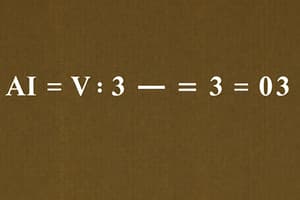Podcast
Questions and Answers
What is the basic accounting equation?
What is the basic accounting equation?
Assets = Liabilities + Equity
What reports a company's financial performance over a period of time?
What reports a company's financial performance over a period of time?
Income statement
According to the historical cost principle, at what value are assets recorded?
According to the historical cost principle, at what value are assets recorded?
Original purchase price
Name one of the two common sets of guidelines that govern the preparation and presentation of financial statements.
Name one of the two common sets of guidelines that govern the preparation and presentation of financial statements.
What is the systematic allocation of the cost of a tangible asset over its useful life called?
What is the systematic allocation of the cost of a tangible asset over its useful life called?
Flashcards
Assets
Assets
Company resources with future economic value.
Liabilities
Liabilities
Obligations a company owes to others.
Equity
Equity
Owners' stake in the company (Assets - Liabilities).
Historical Cost Principle
Historical Cost Principle
Signup and view all the flashcards
Budgeting
Budgeting
Signup and view all the flashcards
Study Notes
- Business accountancy involves the processes of recording, classifying, summarizing, reporting, and interpreting financial transactions for businesses
- It provides stakeholders with essential information for decision-making
- Business accountancy encompasses various specialized fields
Core Concepts
- Assets represent a company's resources and possessions with future economic value
- Liabilities are obligations a company owes to others
- Equity is the owners' stake in the company, representing the residual interest in the assets after deducting liabilities
- The accounting equation (Assets = Liabilities + Equity) serves as the foundation of business accountancy
Financial Statements
- The income statement reports a company's financial performance over a period, detailing revenues, expenses, and net income or loss
- The balance sheet presents a company's assets, liabilities, and equity at a specific point in time, reflecting its financial position
- The statement of cash flows tracks the movement of cash both into and out of a company
- It is categorized by operating, investing, and financing activities
- The statement of changes in equity reconciles the beginning and ending balances of equity accounts during a period
Accounting Principles
- The historical cost principle dictates recording assets at their original purchase price
- The revenue recognition principle determines when revenue should be recognized, typically when earned and realized
- The matching principle requires expenses to be recognized in the same period as the revenues they helped generate
- The going concern assumption presumes a business will continue operating in the foreseeable future
- The accrual basis of accounting recognizes revenues and expenses when they are earned or incurred, regardless of cash flow
Accounting Standards
- Accounting standards are guidelines that govern the preparation and presentation of financial statements
- International Financial Reporting Standards (IFRS) are used globally
- Generally Accepted Accounting Principles (GAAP) are primarily used in the United States
- These standards ensure consistency and comparability in financial reporting
The Accounting Cycle
- The accounting cycle is a series of steps companies use to record, classify, and summarize accounting data
- Transactions are recorded in journals, which are then posted to the general ledger
- Worksheets are prepared to adjust entries
- Financial statements are prepared, and the books are closed
Depreciation
- Depreciation is the systematic allocation of the cost of a tangible asset over its useful life
- Straight-line depreciation allocates an equal amount of depreciation expense each year
- Declining balance methods accelerate depreciation expense in the early years of an asset's life
- Units of production depreciation allocates expense based on actual usage
Inventory Valuation
- First-In, First-Out (FIFO) assumes that the first units purchased are the first ones sold
- Last-In, First-Out (LIFO) assumes that the last units purchased are the first ones sold
- Weighted-average cost calculates a weighted average cost for all inventory items
Cost Accounting
- Cost accounting involves the measurement, analysis, and reporting of costs for decision-making
- Job order costing tracks costs for individual projects or jobs
- Process costing tracks costs for mass-produced, homogeneous products
- Activity-based costing (ABC) assigns costs to activities and then to products based on consumption of those activities
Financial Statement Analysis
- Ratio analysis involves calculating and interpreting financial ratios to assess a company's performance and financial health
- Liquidity ratios measure a company's ability to meet its short-term obligations
- Solvency ratios measure a company's ability to meet its long-term obligations
- Profitability ratios measure a company's ability to generate profits
- Efficiency ratios measure how efficiently a company utilizes its assets
Budgeting
- Budgeting is the process of creating a financial plan for the future
- Operating budgets plan for revenues and expenses
- Capital budgets plan for investments in long-term assets
- Cash budgets plan for cash inflows and outflows
Auditing
- Auditing is the independent examination of financial statements to ensure they are fairly presented
- Internal audits are conducted by employees within the organization
- External audits are conducted by independent outside auditors
- Audits provide assurance to stakeholders about the reliability of financial information
Taxation
- Taxation involves the laws and regulations governing the levying and collection of taxes
- Income tax is levied on taxable income
- Sales tax is levied on the sale of goods and services
- Property tax is levied on real estate and other property
Business Ethics
- Business ethics are moral principles that guide business conduct
- Integrity, objectivity, and confidentiality are essential
- Ethical behavior is critical for maintaining trust and credibility
Technology in Accounting
- Accounting software automates many accounting tasks, improving efficiency and accuracy
- Enterprise Resource Planning (ERP) systems integrate various business functions, including accounting
- Cloud computing enables access to accounting data and applications from anywhere
- Data analytics helps businesses gain insights from financial data
Studying That Suits You
Use AI to generate personalized quizzes and flashcards to suit your learning preferences.




